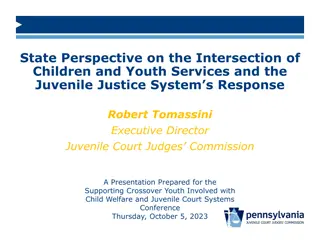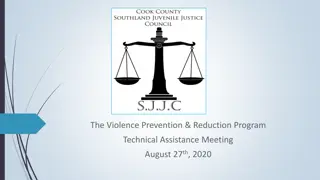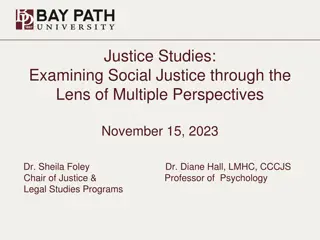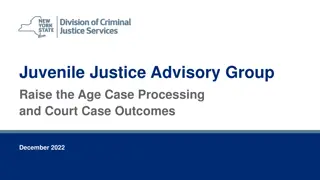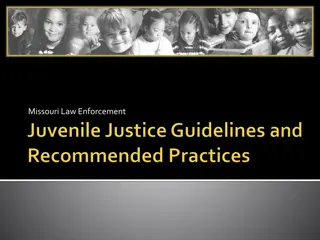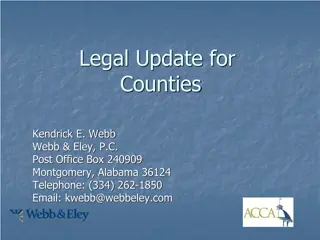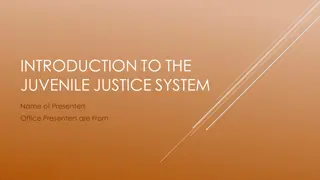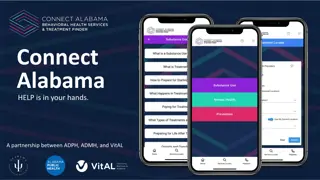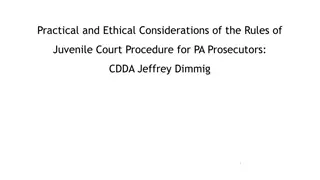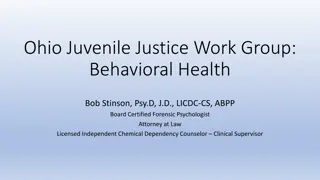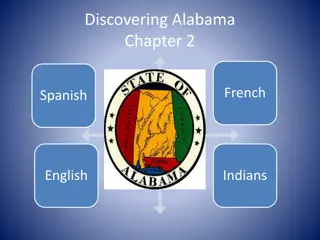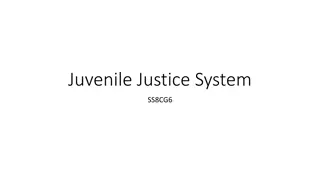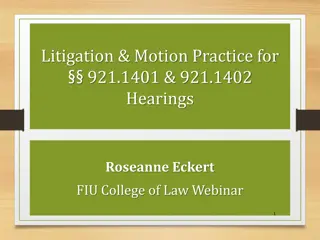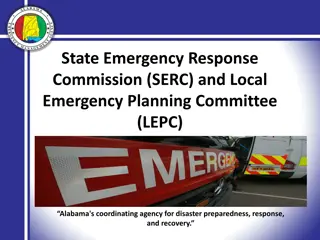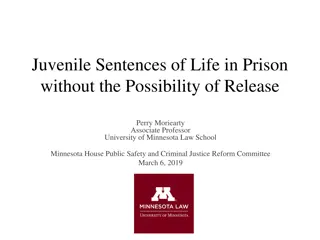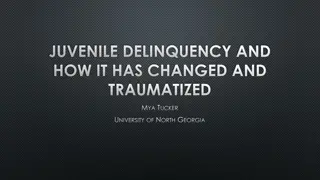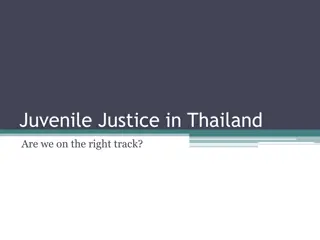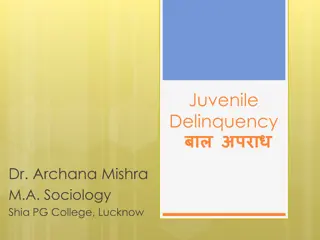Alabama State Advisory Group on Juvenile Justice and Delinquency Prevention Orientation
This presentation serves as an orientation for members of the Alabama State Advisory Group on Juvenile Justice and Delinquency Prevention, providing an overview of the group's role in implementing the ADECA LETS Title II Part B Formula Grant Program. Key terms related to juvenile justice are explained, and the importance of the State Advisory Group's recommendations and contributions to juvenile justice efforts in Alabama is highlighted.
Download Presentation

Please find below an Image/Link to download the presentation.
The content on the website is provided AS IS for your information and personal use only. It may not be sold, licensed, or shared on other websites without obtaining consent from the author. Download presentation by click this link. If you encounter any issues during the download, it is possible that the publisher has removed the file from their server.
E N D
Presentation Transcript
ALABAMA STATE ADVISORY GROUP ON JUVENILE JUSTICE AND DELINQUENCY PREVENTION SAG Orientation
FOREWARD Understanding that State Advisory Group members vary in experience and knowledge of the Juvenile Justice and Delinquency Prevention Act, this presentation serves as an orientation and overview for SAG membership. The SAG is an important component for the implementation of ADECA LETS Title II Part B Formula Grant Program and makes positive contributions in the program s execution and impact. 2
KEY TERMS OJJDP -Office of Juvenile Justice and Delinquency Prevention JJDPA -Juvenile Justice and Delinquency Prevention Act JJRA -Juvenile Justice Reform Act of 2018 SAG -State Advisory Group DSA -Designated State Agency STRAD -State and Tribal Relations Assistance Division CYJT -Center for Youth Justice Transformation ADECA -Alabama Department of Economic and Community Affairs LETS -Law Enforcement and Traffic Safety Division 3
The requirement to establish a State Advisory Group on Juvenile Justice and Delinquency Prevention comes from the Juvenile Justice and Delinquency Prevention Act of 1974 (JJDPA). The JJDPA is a federal law designed to help states address juvenile delinquency and improve the juvenile justice system by providing grants to states based on a state s juvenile population. The JJDPA also created the Office of Juvenile Justice and Delinquency Prevention to administer the Title II Part B Formula Grant Program to states. The Alabama Department of Economic and Community Affairs (ADECA) is the designated state agency charged with implementing the Title II program for Alabama. The Law Enforcement and Traffic Safety Division (LETS) is the division with in ADECA that manages the Title II Grant Program. Buffy Smelley is tasked with managing the Title II program for LETS. EMAIL: buffy.smelley@adeca.alabama.gov PHONE: (334) 353-2554 The SAG has the responsibility to advise and make recommendations for grant applications, develop a comprehensive three-year plan and biennial report to the Governor, and relate issues, trends, practices, and concerns regarding the juvenile justice system and delinquency prevention efforts in Alabama. The SAG meets quarterly throughout the year. Members can attend virtually if needed. INTRODUCTION 4
ABOUT OJJDP The Juvenile Justice and Delinquency Prevention Act of 1974, Public Law 93 415, as amended, established the Office of Juvenile Justice and Delinquency Prevention (OJJDP) to support local and state efforts to prevent delinquency and improve juvenile justice systems. A component of the Office of Justice Programs within the U.S. Department of Justice, OJJDP works to prevent and respond to youth delinquency and protect children. Through its divisions, OJJDP sponsors research, program, and training initiatives; develops priorities and goals and sets policies to guide federal juvenile justice issues; disseminates information about juvenile justice issues; and awards funds to states to support local programming. About OJJDP | Office of Juvenile Justice and Delinquency Prevention (ojp.gov) 5
HISTORY OF THE JJDPA Congress- Enacted the Juvenile Justice and Delinquency Prevention Act in 1974 to support local and state efforts to prevent delinquency and improve the juvenile justice system, Created the Title II Formula Grants program Established what would become known as the Core Requirements, and Reauthorized the JJDPA seven times since 1974. Timeline of the JJDPA 6
JJDPA CORE REQUIREMENTS OJJDP FACT SHEET: JJRA KEY AMENDMENTS Racial and Ethnic Disparities (R/ED) formerly DMC Deinstitutionalization of Status Offenders (DSO) 1974 1988 JJDPA Removal from Jails and Lockups (Jail Removal) 1980 Sight and Sound Separation (Separation) 1974 IN THE INTEREST OF JUSTICE SECTION 223 (A)(11)(B) 7
DSO DEINSTITUTIONALIZATION OF STATUS OFFENDERS Youth who are: Charged with or who have committed an offense that would not be criminal if committed by an adult; Non-offenders who are aliens; and Non-offenders alleged to be dependent, neglected, or abused shall not be placed in a secure detention or a correctional facility.
SIGHT AND SOUND SEPARATION (SSS) Juveniles alleged to be or found to be delinquent (or status offenders and nonoffenders who are aliens or non-offenders alleged to be dependent, neglected, or abused) will not be detained or confined in any institution in which they have sight or sound contact with adult inmates. By December 21, 2021, states must comply with the interest of justice requirement that applies to youth who are awaiting trial as adults. SEC. 223(a)(12)
JAIL REMOVAL (JR) No juvenile will be detained or confined in any jail or lockup for adults. By December 21, 2021, states must comply with the interest of justice requirement that applies to youth who are awaiting trial as adults. SEC. 223(a)(13)
IN THE INTEREST OF JUSTICE In the Interest of Justice Require that Not later than 3 years after the date of enactment of the Juvenile Justice Reform Act of 2018, unless a court finds, after a hearing and in writing, that it is in the interest of justice, juveniles awaiting trial or other legal process who are treated as adults for purposes of prosecution in criminal court and housed in a secure facility shall not have sight or sound contact with adult inmates; and except as provided in paragraph (13), may not be held in any jail or lockup for adults SEC. 223(a)(11)(B) 11
Two compliance monitors monitor for compliance with the JJDPA core requirements of DSO, JR, and SSS. ROLE OF A COMPLIANCE MONITOR Knowing and fully understanding the core requirements and the requirements of an effective system of monitoring, including OJJDP policy guidance Annual update and review of the state s Compliance Monitoring Policy and Procedure Manual Identification and classification of the monitoring universe Data collection and data verification Developing and implementing an effective system of monitoring for compliance Monitoring compliance with DSO, Sight and Sound Separation, Jail Removal, and Interest of Justice Submitting a plan for compliance monitoring, the monitoring universe, and compliance data to OJJDP addressing compliance issues Identifying and responding to the types and locations of violations Engaging in collaborative site visits to address compliance shortfalls Hosting regional law enforcement trainings with SAG involvement 12
RACIAL AND ETHNIC DISPARITIES (R/ED) The term racial and ethnic disparity means minority youth populations are involved at a decision point in the juvenile justice system at disproportionately higher rates than nonminority youth at the same decision point. Step 1: Identify the problem Step 2: Develop an Action Plan SEC. 223(a)(15) Step 3: Outcome- Based Evaluation The Racial and Ethnic Disparity Coordinator is responsible for data collection, data distribution, developing an R/ED plan, and communicating disparities with stakeholders. Three Steps to Addressing R/ED 13
SAG ROSTER REQUIREMENTS
STATE ADVISORY GROUPS MUST CONSIST OF NOT LESS THAN 15 MEMBERS AND NOT MORE THAN 33 MEMBERS. SAG MEMBERS ARE APPOINTED BY THE CHIEF EXECUTIVE AND MUST INCLUDE REPRESENTATIVES OF THE CATEGORIES BELOW. A. B. At least one locally elected official representing general purpose local government; Representatives of law enforcement and juvenile justice agencies, including juvenile and family court judges, prosecutors, publicly supported court-appointed legal counsel for children and youth charged in delinquency matters, and probation workers; Representatives of public agencies concerned with delinquency prevention or treatment, such as welfare, social services, children s mental health, education, child and adolescent substance abuse, special education, services for youth with disabilities, recreation, and youth services; Representatives of private nonprofit organizations, including persons with a special focus on preserving and strengthening families, parent groups and parent self-help groups, youth development, delinquency prevention and treatment, neglected or dependent children, the quality of juvenile justice, education, and social services for children; Volunteers who work with delinquent youth or youth at risk of delinquency; Representatives of programs that are alternatives to incarceration, including programs providing organized recreation activities; Persons with special experience and competence in addressing problems related to school violence and vandalism and alternatives to suspension and expulsion; Persons, licensed or certified by the state, with expertise and competence in preventing and addressing mental health and substance abuse needs in juvenile delinquents and those at risk of delinquency; Representatives of victim or witness advocacy groups, including at least one individual with expertise in addressing the challenges of sexual abuse and exploitation and trauma, particularly the needs of youth who experienced disproportionate levels of sexual abuse, exploitation, and trauma before entering the juvenile justice system; For a state in which one or more Indian Tribes are located, an Indian tribal representative (if such a representative is available) or other individual with significant expertise in tribal law enforcement and juvenile justice in Indian tribal communities. C. D. E. F. G. H. I. J. A majority of which members (including the chairperson) shall not be full-time employees of the Federal, State, or local government; At least one-fifth of which members shall be under the age of 28 at the time of appointment; and At least three members who have been or are currently under the jurisdiction of the juvenile justice system 15
Executive Order 2014-46 named the Alabama State Advisory Group as the entity appointed to fulfill the requirements of Section 223 of the Juvenile Justice and Delinquency Prevention Act. ESTABLISHED Attend quarterly SAG meetings, special meetings, and annual conference. MEETINGS Submit biennially to the Governor recommendations related to its functions, including State compliance with requirements of the JJDPA and any other SAG concerns. REPORTING Assist in the development, writing, and implementation of the State s Title II Formula Grant Comprehensive Three-Year Plan. THREE-YEAR PLAN ALABAMA SAG 16
Monitor the States compliance with the Core Requirements of the JJDPA. RESPONSIBILITIES Develop procedures that address Request for Applications, receipt of applications, review of applications, and recommend funding for projects funded with Title II funds. Review and comment on all contract and grant applications submitted for consideration. RESPONSIBILITIES Review the progress and accomplishments of the projects funded under the State plan. RESPONSIBILITIES RESPONSIBILITIES Regularly seek comments, recommendations, and opinions from juveniles currently under the jurisdiction of the juvenile justice system. ALABAMA SAG 17
ALABAMA SAG AREAS OF FOCUS Membership Community-based programs JJDPA Compliance Having relevant impact for Alabama juveniles 18
We are very thankful for your willingness to serve on the Alabama State Advisory Group on Juvenile Justice and Delinquency Prevention. Your time and experience are greatly appreciated! 19




